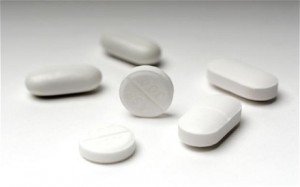
January 12, 2011
Take two NSAIDs after a workout…Not!
Feeling sore after a workout? What do you do? Perhaps pop a couple of Advil, Motrin, Aleve, or some other brand of non-steroid anti-inflammatory drug (NSAID) and wait for the discomfort to subside? If so, you might want to reconsider. Here’s why…

These drugs work by blocking an enzyme called cyclooxygenase (COX). COX catalyzes the production of various prostanoids that play a role in inflammation and algesia. Theoretically, reducing prostanoids should help to alleviate localized muscle muscular pain.
Most research, however, fails to support the efficacy of NSAIDs in reducing muscle soreness. For instance, creatine kinase levels (a marker of muscle damage) have not been shown to be significantly different between those taking NSAIDs and a placebo group, indicating that NSAIDs have little effect on attenuating the root cause of pain. Moreover, the majority of studies show no differences in self-described pain ratings associated with muscle soreness after taking NSAIDs. This is particularly true in severe cases of muscle soreness, which is when a pain reliever would be of greatest value.
While a lack of effectiveness in reducing post-workout pain is certainly reason enough to avoid NSAIDs, there is a larger issue here for those who are serious exercisers. Namely, prostaglandins are known to regulate protein metabolism. Specifically, they help to stimulate protein synthesis, which is the mechanism by which muscles repair themselves and grow stronger. Studies have shown that post-exercise protein synthesis is virtually non-existent following consumption of NSAIDs. And if your muscles don’t synthesize protein after a workout, you won’t see any appreciable improvements in muscle development.
If that wasn’t enough, there is emerging evidence that NSAIDs may impair satellite cell activity. Satellite cells are muscle stem cells that have a number of functions in promoting muscle development. When activated by exercise, they multiply in number, become more specialized, and then fuse to existing muscle fibers to provide the precursor materials needed for repair and subsequent growth of new muscle tissue. Perhaps more importantly, they donate their nuclei to the stimulated muscle fibers so that protein synthesis can be increased to support growth.
Bottom line: Try to steer clear of NSAIDs whenever possible. Understand that the inflammatory response following an intense training session is part of the healing process that is necessary to develop your muscles. Shortchange healing and you shortchange muscular development.
So what to do about the pain from soreness? The best advice is to stay active—don’t just lie in bed or sit around at your desk all day. An active recovery will help to maintain blood flow to the affected muscles, which will aid in healing. There is some evidence that massage can help to restore muscle function and reduce achiness. It’s certainly worth a try. If nothing else, it can provide temporary relief by taking your mind off the pain.
Stay Fit!
Brad
No Comments
No comments yet.
RSS feed for comments on this post.
Sorry, the comment form is closed at this time.





 Entries (RSS)
Entries (RSS)



